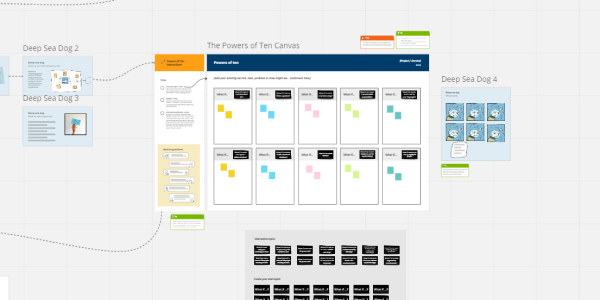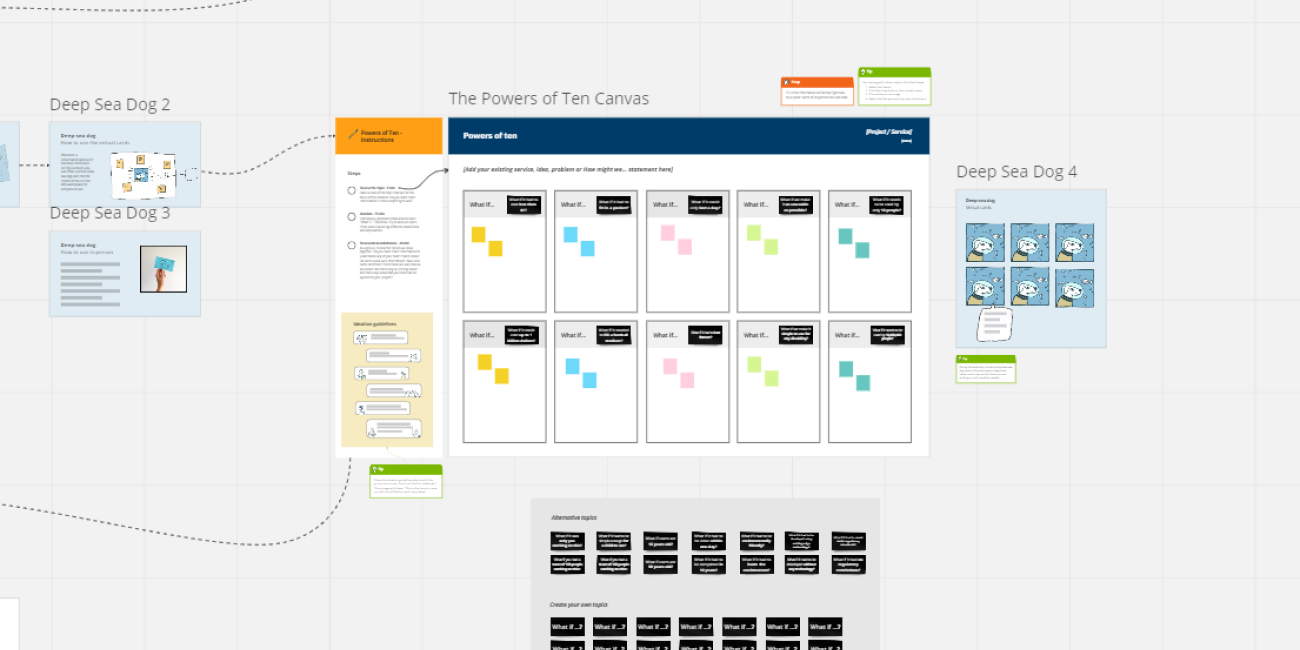Powers of ten
This is an ideation play that encourages us to generate ideas based on polar opposite constraints. By exploring extreme scenarios and contrasting conditions, we are challenged to think creatively and test the boundaries of our ideas.
Participants are encouraged to think beyond the immediate problem, idea or solution and consider the broader context, stakeholders, and consequences. By incorporating this concept into the ideation workshop activities, participants can develop more innovative, user-centric, and impactful design outcomes.

Outcomes
- A broad range of ideas generated around a topic
- Unique solution possibilities that normally wouldn't have been surfaced
What you need
| Remote | In-person |
|---|---|
|
|
Instructions
For this play, there is a small amount of preparation required to help your participants understand the goal and get the most out of the session.
This play is very versatile, and you can start from many different angles. Depending on what you are after, you can start with a problem, a “how might we...” question, an existing service, or even an idea.
If you intend to start with a problem, we recommend doing the following plays if haven’t already:
Invite your participants
Calendar meeting request for powers of ten
Subject:
Join us for a powers of ten session for [project name]
Meeting description:
Hi [team name if sending a group invitation, or participant name if sending individual invitations]
As part of our work on [name of project], we’re looking to do some creative thinking as part of the project.
The session will take about [x] minutes and there is no preparation required.
Having [you/each of you] attend will help to make sure we are including a diverse range of opinions and expertise in our project. [If conducting the session virtually include the following- We will be using Miro for this workshop].
If you would like some further insight into the activity you can read more on the Powers of ten in the Digital service design playbook.
I look forward to your contribution to the session. [If you’re planning to record the session include the following - We will be recording the session for learning and development purposes and recordkeeping. Please let us know before the session if you don't want to be included in the recording or transcript].
The [project name] team is committed to inclusion for our events, and we appreciate the experience of inclusion is not the same for everyone. Please let us know what we can do to make our events more accessible and inclusive for you.
Kind regards,
[Facilitator name]
1. Introduction
If using Miro, check that everyone knows how to navigate and use the board. You can view and present the introductory slides in Miro if you are running the session remotely.
Welcome the team and start by explaining the goal, expected outcomes, and what activities you will run in the session.
Introduce the concept around the power of ten: explain that this is an ideation activity that encourages participants to generate ideas based on polar opposite constraints. By exploring extreme scenarios and contrasting conditions, the group is challenged to think creatively and test the boundaries of their thinking.
When showing the participants our ideation guidelines, go through each of the guiding principles and ask if any of the participants have questions around the guidelines. Ideation activities are meant to be full of ideas, and there is no such thing as a bad idea. The more ideas we have, the better!
2. Warm up activity: this n’ that -10 mins
Explain to the participants that a warm up activity is a quick and playful activity before jumping into the brainstorm. This will get people ready for the divergent thinking that they will do for the rest of the session.
In this activity, participants will try to come up with creative solutions by combining 2 different objects. This warm up activity will encourage creative thinking and combining unusual concepts. This will encourage participants to share crazy ideas and build on each other's concepts.
If you are running this play remotely, you will have access to the instructions around how to run this warm up in the Miro template. If you are running the play in person, you can view the instructions on the Miro template, and use sticky notes for the activity.
3. Powers of ten – 40 mins
Deep-sea dog – 2 min
Talk through the deep-sea dog slides and how the deep-sea dog cards can be used to keep the group on track if the conversation goes too much into detail or off on a tangential topic during the session.
3a. Review the topic - 5 min
Start by presenting the main topic that will be the focus of the ideation, providing any background information if necessary. This is a good place for participants to ask questions or add any details to the ideation topic.
3b. Powers of ten - 15 min
Ask the participants to individually generate ideas around each "what if..." question in the working area. Remind the group to keep an open mind, while exploring different possibilities and approaches.
This is a great time to remind the participants of the ideation guidelines once more. You can find them on the Miro board next to the activity working area or download a copy here.
Let participants know that they should use one idea per sticky note and that ideas need to be clear and specific. For example, ‘education' is not specific enough. It needs to be clarified further, like this: 'Human centred design learning posters in every office', 'explainer videos to educate staff' and so on.
3c. Review ideas and discuss - 20 min
With the whole group, review the individual ideas together. Do you need more information to understand any of your teammates’ ideas? Do some areas lack information? Have silos been identified? Point these out and discuss as a team. Are there any surprising ideas? Are there any ideas that you think can be applied to your project?
Once you've completed the session, spend 30 minutes going over the play outcomes. You can do this individually as a facilitator, or if you’d prefer, you can run a team debrief. Spend this time tidying up the board to help with reviewing outcomes later.
Now that you have a list of ideas, your team can use these to prioritise the best ideas through voting, and then prototype and test the chosen ideas with users.
You can use the following plays to proceed to the next steps:
Resources
See below for a collection of templates and other pages which will help you run this play. These resources are also linked in the play instructions.
Subject:
Join us for a powers of ten session for [project name]
Meeting description:
Hi [team name if sending a group invitation, or participant name if sending individual invitations]
As part of our work on [name of project], we’re looking to do some creative thinking as part of the project.
The session will take about [x] minutes and there is no preparation required.
Having [you/each of you] attend will help to make sure we are including a diverse range of opinions and expertise in our project. [If conducting the session virtually include the following- We will be using Miro for this workshop].
If you would like some further insight into the activity you can read more on the powers of ten in the Digital service design playbook.
I look forward to your contribution to the session. [If you’re planning to record the session include the following - We will be recording the session for learning and development purposes and recordkeeping. Please let us know before the session if you don't want to be included in the recording or transcript].
The [project name] team is committed to inclusion for our events, and we appreciate the experience of inclusion is not the same for everyone. Please let us know what we can do to make our events more accessible and inclusive for you.
Kind Regards,
[Facilitator name]

